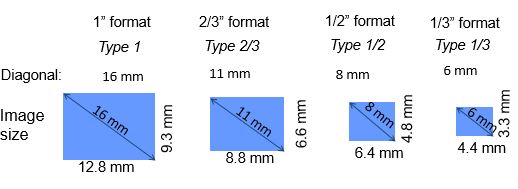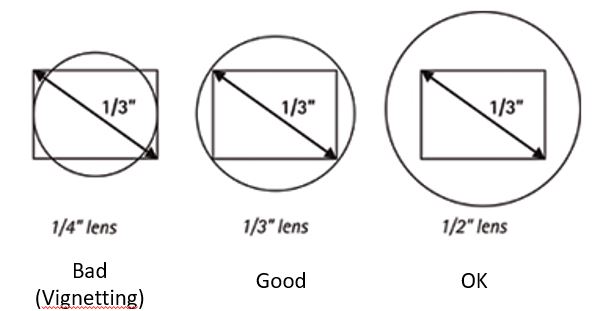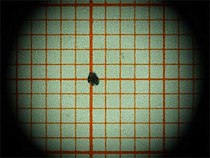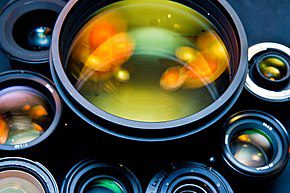Common lens questions we are often asked are, “What is a lens’s optical format (or size; we will use the two interchangeably) and how does it relate to specific image sensor sizes in industrial cameras? Along with, “Can any size machine vision camera be used on any lens format or do they need to be matched exactly?”
First lets review the sizes of the machine vision camera image sensors themselves (as seen below).

The image sensor size is typically put in terms of “inches”, but really has nothing to do with this and dates back to the “image tube” days. Without a big history lesson, a sensor that fit into an image tube with a 1” (inch) yoke was deemed a 1” image format . Today, we still use these terms and see commons sizes stated as 1/3”, ½”, 2/3” as seen in the image above. Note: The image size in ” does NOT calculate to mm and vice versa! It is nomenclature only.
However, what is important is to look at the diagonal across the given image sensor which is the “image circle”. (i.e The 1/3” format above has a diagonal of 6 mm. )
The size of the lens MUST be equal or greater than the size of the sensor ( circle size that covers the sensor) or you simply will not get the whole image!

The diagram above shows a 1/3″ format image sensor (6mm diagonal). In order to adequately cover the image sensor, you need a 1/3″ lens format or larger. On the left, we show a lens with a 1/4″ format, and it does not cover the sensor.

The end results from the improper mating of a smaller lens format than the image sensor format will be vignetting (dark corners where the lens does not cover the sensor) of the image.
What can I do when there is no specific lens format matching the image sensor format?
Lens manufacturers are continuing to design lenses to address the changing sensor market. However you will not always find a specific size format to match the lens. In these cases, you just need to ensure the lens format (image circle diameter) is larger than the sensor as mentioned in the above example.
An example is the newer 1/1.2” sensor sizes (IMX174, IMX249 ) which have a diagonal of 13.4mm. Although there are some lens manufacturers that designed a lens with the specific 1/1.2” format, there are not many. Referring to lens format diagram, the 1/1.2” format is between a 2/3” and 1” format. The 2/3” format has a image circle of 11 mm which will not fully cover the 1/1.2” format (13.4mm diagonal), and you will get vignetting of the image. The solution is to use the next size up which is a 1” format. This format is commonly found in many lens manufacturers, in turn providing many lens manufacturers to choose from.
Click here now for all lens sizes and manufacturers
In conclusion, you can use an image format on a lens on smaller image sensor size, but not the other way!.. You’ll have vignetting and lose part of your image!
What else do we need to consider in lens selection?
This blog post simply covers sensor formats vs sensor sizes. There is much more to consider in a lens selection such as resolution of the lens to resolve the pixels themselves, what focal length is needed etc.
Here are some further resources to help in the selection process. Additionally, 1st Vision has over 100 years of combined experience in industrial imaging in which you can contact us to aid in the section.
How to choose a lens –
Calculating resolution for a machine vision application – https://www.1stvision.com/machine-vision-solutions/2015/07/imaging-basics-calculating-resolution.html
Video Tutorial – Using the On-line lens focal length calculator https://www.youtube.com/watch?feature=player_embedded&v=baF4lwl0LwM
1st Vision newly added our high quality 1” format lenses which provide an excellent price vs performance ratio – Read more here.
Images courtesy of Wikipedia
